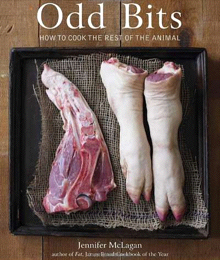
Maybe you’ve played that foodie game: What’s the most interesting thing you ever cooked or eaten? Suckling pig kidneys? Nutria? Camel’s milk?
If that is fun to you, then you’ll love the excellent book, Odd Bits: How to Cook the Rest of the Animal (Ten Speed 2011) by Jennifer McLagan. Jennifer knows her animals – she’s written two terrific books that take a look at cooking meat in fascinating ways: Bones (Super Chef‘s review) and Fat (Super Chef‘s review). All three books are clever, entertaining, and authoritative.
Leigh Beisch‘s photography turns a pig’s head in a frying pan, with a beef tongue, heart, and kidney lying on butcher’s paper into a still life study. It’s a photograph that makes us considers the thyme, the peppercorns, and the bay leaf with respect.
Odd Bits starts with challenging us to rethink animals and the prime meat that we most often cook:
But, why is it strange to eat a beef cheek than a cow’s back? Why do people chew a rib chop but recoil at roasted marrow bones? Why do we happily eat a lamb chop, but overlook lamb neck? (p. 1)
She is determined to change our minds with excellent recipes and her own story of being converted, first with tripe soup in France. There are plenty of tripe recipes here, as well as an essay on trip including a story of George Washington’s troops eating a peppery tripe soup (pp. 144-5).
 The first chapter is called Get a Head: Challenging covers headcheese, including an excellent recipe, Headcheese for the Unconvinced (p. 17) . She covers ears, beef cheeks, pork cheeks, brain, including her favorite Cheese and Just a Little Brain Fritters (p. 42). She covers tongue in depth with a guide on how to choose and cook a tongue, including the snappy Spicy Tongue Tacos (p. 55) with chili and almonds. Finally, she includes an essay on even odder bits: palates and eyeballs. These are essays considering historical recipes and her own experiences: ” My first eyeball experience was while eating a dish of sheep’s head couscous. The split sheep’s head was in a broth of vegetable, and the host offered me the eyes. I ate one and then asked for the brain. (p. 65). Evidently, a hard-to-acquire taste.
The first chapter is called Get a Head: Challenging covers headcheese, including an excellent recipe, Headcheese for the Unconvinced (p. 17) . She covers ears, beef cheeks, pork cheeks, brain, including her favorite Cheese and Just a Little Brain Fritters (p. 42). She covers tongue in depth with a guide on how to choose and cook a tongue, including the snappy Spicy Tongue Tacos (p. 55) with chili and almonds. Finally, she includes an essay on even odder bits: palates and eyeballs. These are essays considering historical recipes and her own experiences: ” My first eyeball experience was while eating a dish of sheep’s head couscous. The split sheep’s head was in a broth of vegetable, and the host offered me the eyes. I ate one and then asked for the brain. (p. 65). Evidently, a hard-to-acquire taste.
The following chapter covers more familiar territory, the front of the animal – the shoulders, neck, breast, and the feet. Here, Jennifer includes some wonderful stew recipes for lamb neck and goat shoulder stew from West India (p. 78). There is an ample section on gelatin, including several recipes for calf’s foot jelly and Blood Orange Jelly (p. 110). Then Jennifer includes an interlude, a chapter on how to cook a suckling pig.
Jennifer McLagan writes excellent cookbooks, full of witty writing, personal experiences, and unusual recipes. Odd Bits will make you search out a good butcher who can save those hard-to-find pieces of cows, sheep, and pigs for you – the parts of the animal that make eating an adventure.
